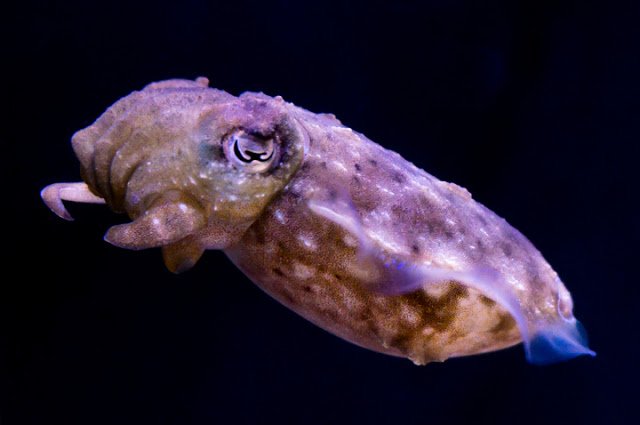
Cuttlefish are bizarre and beautiful creatures. Above is a photo I took of a dwarf cuttlefish at the Seattle aquarium. If you check out its eye you'll notice the cuttlefish, has a "W" shaped pupil. Humans of course have round pupils. As the ambient light in the environment decreases our pupils increase in size in order to let in more light making the eye more sensitive. The pupils of the cuttlefish do the same thing, but check out what happens in the video below. Watch the cuttlefish's pupil over the duration of the video:
Source: creator: Tliglesias, Wkimedia Creative Commonshttps://upload.wikimedia.org/wikipedia/commons/transcoded/0/08/Sepia_eyelid_shape.theora.ogv/Sepia_eyelid_shape.theora.ogv.480p.webm
Notice how it starts out in a "w" shape but then about half way through the video the cuttlefish's pupil increases in size but also changes shape and becomes round. Why would a cuttlefish have a pupil that can change shape? Well the nice big round pupil is perfect for low light situations as you would get the maximum number of photons pasing through the pupil and onto the retina. It also makes sense that you would want a pupil that can decrease in size as the light intensity increase as to protect the retina. However the question still remains: why a "w" shaped pupil?
This is a question many people have been pondering including the scientists who published the 2013 paper entitled "The W-shaped pupil in cuttlefish (Sepia officinalis): Functions for improving horizontal vision." In the paper, researchers Lydia M. Mäthger, Roger T. Hanlon, Jonas Håkansson, and Dan-Eric Nilsson tried to solve the mystery of the "w" shaped pupil. Before we get into exactly what they found it is important to remember the environment that the cuttlefish finds itself: the ocean. As light enters the surface of the water it is quickly scattered. This means that the deeper you go the less light there is, which creates a light gradient. What they found is that the weird shaped pupils create vertical slits that control the light illumination on the retina. This causes even lighting across the retina. This means that even though there is a light gradient through the water the cuttlefish sees a nice even view of the ocean in front of them. When the light starts to drop the pupil grows in size to let more light in. This is why the pupil changes to a round shape as that will allow the greatest number of photons to hit the retina collecting the light. By having a pupil that can change between the two states the cuttlefish doesn't have to compromise between clarity and sensitivity.
Sources:
https://commons.wikimedia.org/w/index.php?title=User:Tliglesias&action=edit&redlink=1
Mäthger, L. M., Hanlon, R. T., Håkansson, J., & Nilsson, D. E. (2013). The W-shaped pupil in cuttlefish (Sepia officinalis): Functions for improving horizontal vision. Vision Research, 83, 19–24. doi:10.1016/j.visres.2013.02.016
Very interesting. Cuttlefish are fascinating but I never thought about the w-shaped eyes.
meep
Congratulations @mtross! You have completed some achievement on Steemit and have been rewarded with new badge(s) :
Click on any badge to view your own Board of Honor on SteemitBoard.
For more information about SteemitBoard, click here
If you no longer want to receive notifications, reply to this comment with the word
STOP